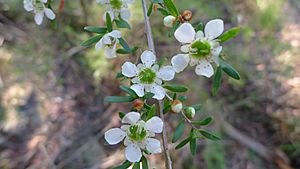Jellybush facts for kids
Quick facts for kids Tantoon |
|
|---|---|
 |
|
| Scientific classification | |
| Genus: |
Leptospermum
|
| Species: |
polygalifolium
|
| Synonyms | |
|
List
Leptospermum aquaticum Otto & A.Dietr. nom. inval., pro syn.
Leptospermum buxifolium H.L.Wendl. Leptospermum flavescens f. microphyllum Siebert & Voss Leptospermum nervosum Otto & A.Dietr. nom. inval., pro syn. Leptospermum obtusum G.Don nom. inval., nom. nud. Leptospermum polygalaefolium Salisb. orth. var. Leptospermum retusum Otto & A.Dietr. nom. inval., pro syn. Leptospermum roseum Otto & A.Dietr. nom. inval., pro syn. Leptospermum stellatum Cav. p.p. Leptospermum stellatum Cav. f. stellatum p.p. Leptospermum stellatum Cav. var. stellatum p.p. Leptospermum stellatum var. typicum Hochr. nom. inval. p.p. Leptospermum thea (Schrad. & J.C.Wendl.) Willd. Melaleuca thea Schrad. & J.C.Wendl. |
|
Leptospermum polygalifolium, also known as tantoon, jellybush, or yellow tea tree, is a cool plant found only in eastern Australia, including a special place called Lord Howe Island. It's either a shrub (a bushy plant) or a tree. This plant has thin bark, oval-shaped leaves, and pretty white flowers that grow by themselves on short side branches. After the flowers, it grows fruits that stay on the plant for a few years. It belongs to the Myrtaceae family, which also includes eucalyptus trees!
Contents
What Tantoon Looks Like
The Tantoon plant, or Leptospermum polygalifolium, is usually a shrub that grows about 0.5 to 3 meters (about 1.5 to 10 feet) tall. Sometimes, it can even grow into a tree up to 7 meters (about 23 feet) or more! Its bark is usually thin, but on older, larger plants, it can be thick and flaky.
Younger stems of the Tantoon plant are covered with short hairs. They also have a noticeable ridge or "flange" near where the leaves attach.
Tantoon Flowers and Fruit
The flowers of the Tantoon plant are mostly white. But sometimes, they can be greenish, cream-colored, or even a little pink! They are usually about 10 to 15 millimeters (about 0.4 to 0.6 inches) wide. Each flower grows alone on short side shoots.
At the bottom of the young flower buds, there are small, leaf-like parts called bracts. These fall off as the bud grows. The base of the flower, called the floral cup, is usually smooth and about 2 to 4 millimeters long. It sits on a tiny stem called a pedicel, which is about 1 millimeter long.
The flower has sepals, which are like small leaves that protect the bud. They are broadly egg-shaped and about 1.5 to 2.5 millimeters long. These also fall off before the fruit appears. The actual petals of the flower are about 4 to 6 millimeters long. Inside, the stamens (the parts that make pollen) are about 2.5 to 4 millimeters long.
Tantoon plants mostly flower from August to January. After flowering, they produce a fruit called a capsule. This capsule is about 5 to 8 millimeters wide and stays on the plant for a few years.
How Tantoon Got Its Name
The plant Leptospermum polygalifolium was first officially described in 1797. A person named Richard Anthony Salisbury wrote about it after finding a sample near Port Jackson in Australia. He published his description in a book called Prodromus Stirpium in Horto ad Chapel Allerton Vigentium.
The second part of its scientific name, polygalifolium, is a clue about what it looks like. It refers to another plant genus called Polygala. The ending -folium comes from Latin and means "leaved," so polygalifolium means "having leaves like a Polygala plant."
Different Types of Tantoon
In 1989, a botanist named Joy Thompson studied Tantoon plants very carefully. She found that there are six different types, or "subspecies," of Leptospermum polygalifolium. These different types are recognized by the Australian Plant Census. They mostly differ in where they grow and small details about their leaves, flowers, and fruits.
Here are the six subspecies:
- Leptospermum polygalifolium subsp. cismontanum: This type has leaves that are about 8–10 mm long and 2 mm wide, often with edges that curl under. Its white flowers are about 10 mm wide, and its fruit is 5–7 mm wide. You can find it from Fraser Island to Gosford.
- Leptospermum polygalifolium subsp. howense: This type has leaves about 5–8 mm long. Its white flowers are about 15 mm wide, and its fruit is 5–8 mm wide. This subspecies is special because it only grows on Lord Howe Island.
- Leptospermum polygalifolium subsp. montanum: This type has leaves about 10–15 mm long and 3–5 mm wide, often with curled edges. Its white flowers are about 12 mm wide, and its fruit is 6–9 mm wide. It grows in the mountains of eastern Australia, from Southeast Queensland to Barrington Tops.
- Leptospermum polygalifolium subsp. polygalifolium: This is the main type. It has leaves about 10–20 mm long and 2–3 mm wide, often with curled edges. Its flowers are greenish or creamy-white and about 12 mm wide. Its fruit is 6–10 mm wide. It grows from central eastern New South Wales down to the border with Victoria.
- Leptospermum polygalifolium subsp. transmontanum: This type has flat, stiff leaves about 10–15 mm long and 2 mm wide. Its white flowers are 10–12 mm wide, and its fruit is 6–7 mm wide. It grows from the White Mountains in Queensland to the Hunter River in New South Wales.
- Leptospermum polygalifolium subsp. tropicum: This type has leaves about 5–20 mm long and 1–1.5 mm wide. It grows in tropical areas from Cooktown to Keppel Bay in Queensland.

